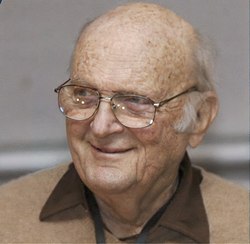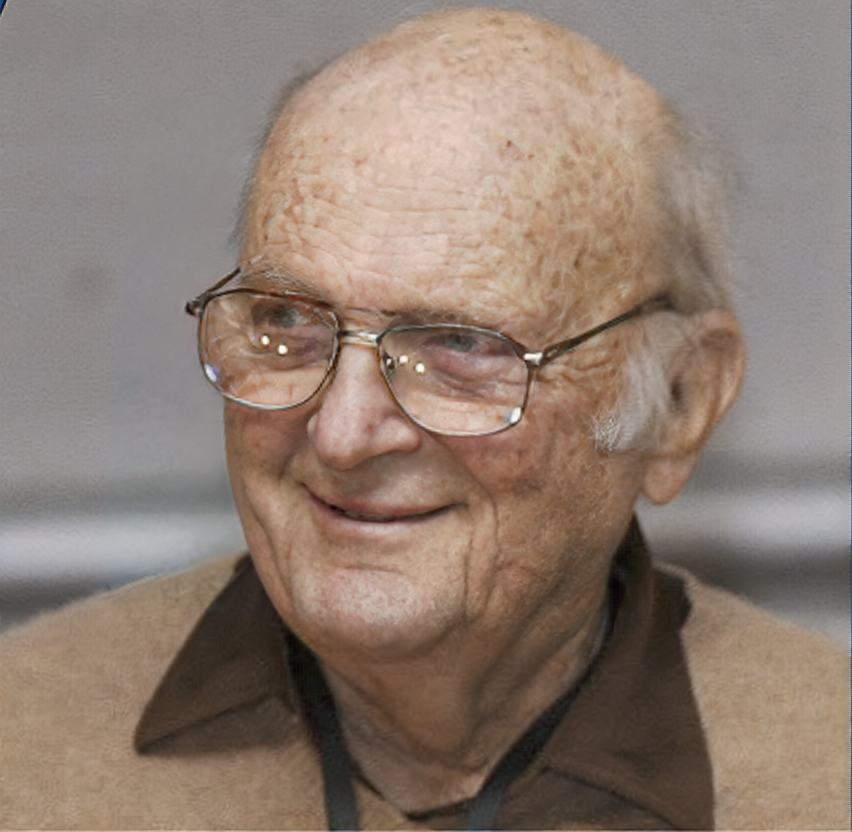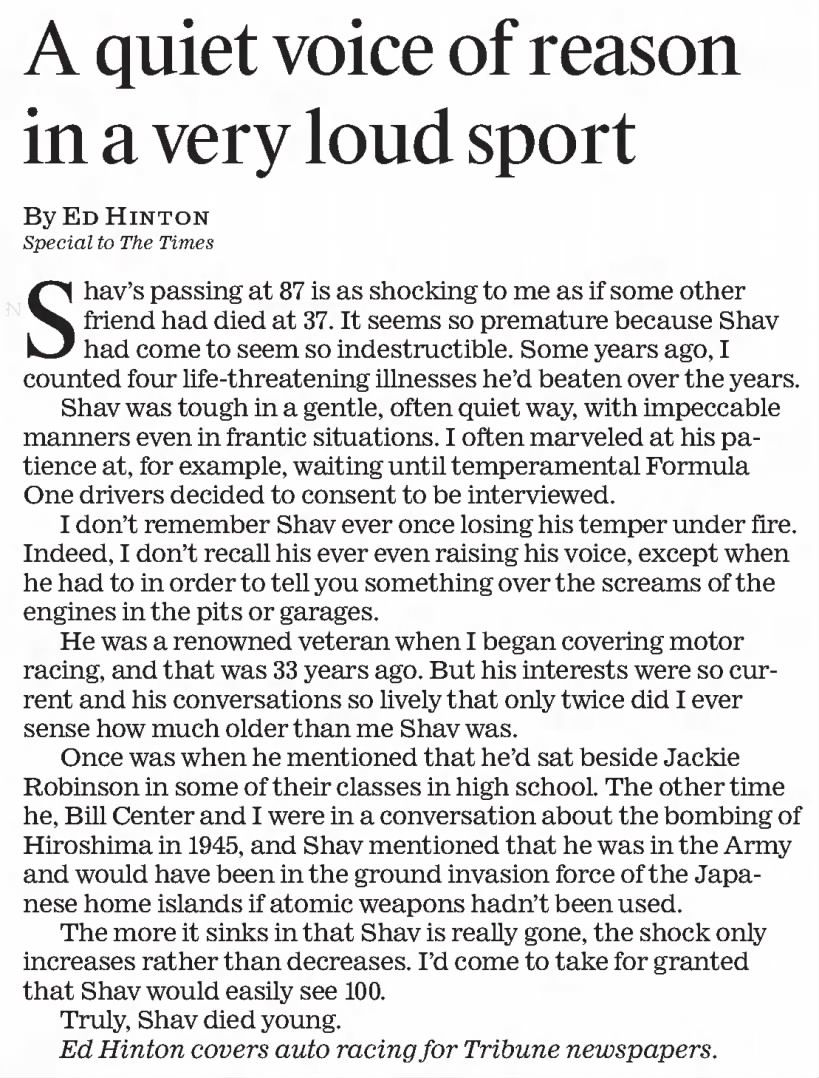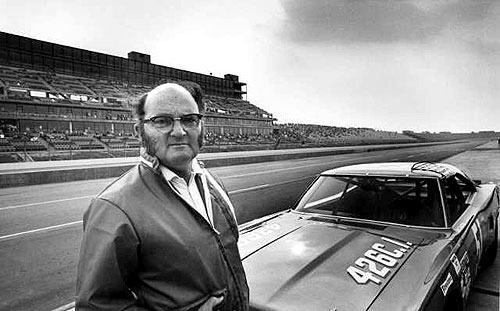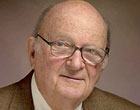Shav Glick is the 2024 recipient of the Squier-Hall Award for NASCAR Media Excellence. It is named after legendary NASCAR media figures Ken Squier and Barney Hall, the first two recipients of the award. Shav was honored during the NASCAR Hall of Fame Induction Ceremony festivities on January 19, 2024 and is featured in an exhibit in the NASCAR Hall of Fame in Charlotte, North Carolina.
By Mike Kupper, Special to The Times
October 21, 2007
Shav Glick, whose insightful coverage of motor sports for The Times made him nearly as famous as the racing stars he chronicled, died Saturday at his Pasadena home of complications from melanoma, said his companion, Doris Syme. He was 87.
He married Florence Harriet (MAYS) Hale on 9 June 1950 in Los Angles, California.
"He was the authority. You wanted to be noticed by Shav Glick. He certainly had my respect," legendary race car driver Mario Andretti said Saturday. "I'll always remember him very, very fondly."
—————————————————————————-
Shav Glick writes: "It's Junior Johnson Country"
Related Stories
- Glick a race winner
- A quiet voice of reason in a very loud sport
- Shav Glick, 1920-2007
Fred Nation, an executive vice president of the famed Indianapolis Motor Speedway, called Glick "that rare reporter who combined style, savvy, courtesy and courage to produce the best consistent motor sports reporting of his generation."
Glick came to sportswriting early in life but to the motor racing facet of it relatively late.
He wrote his first bylined story, for the Pasadena Post, when he was 14. By the time he was assigned the racing beat at The Times, he was 48, had already spent 34 years covering other sports -- less three years for Army service during World War II -- and was gaining renown as a golf writer.
"In 1969, I was suddenly thrust into racing," he recalled a few years ago. "I had no background in racing as such."
And yet Glick and motor racing went together like biscuits and gravy. So taken with it was he that he made sure he covered the entire spectrum.
He was as likely to be at a sprint car race in Ventura as at the Indianapolis 500. He covered short tracks and super speedways, road racing and drag racing and midget cars. He was fascinated by unlimited hydroplane racing and, once in the dead of winter, went to La Crosse, Wis., to get a story about stock cars racing on ice.
In the 37 years he covered racing -- he was 85 when he retired in 2006 -- he won more awards than some good drivers win races. He even had one named for him, the Shav Glick Award, given annually by sponsor Eagle One for distinguished achievement in motor racing by a Californian. The winners, chosen by a panel of sportswriters and public relations directors, represent various areas of racing but have one thing in common: Glick wrote often about each of them.
In 1994, he was inducted into the Motorsports Hall of Fame of America in Novi, Mich., becoming the first writer for a general circulation daily newspaper to earn that honor. "What astonishes me," Glick said, "is the list of people in my category -- Roger Penske, Tony Hulman, J.C. Agajanian."
Penske owns teams in both open-wheel and stock car racing and has been one of the most influential men in racing for more than 30 years; Hulman owned the Indianapolis Motor Speedway; and Agajanian, a car owner and promoter, was a West Coast racing legend. As befitting a racing writer, Glick was in fast company.
"He was a true friend of mine, a friend of the sporting world and someone with high integrity," Penske said Saturday. "I have a lot to thank him for, and so does the entire motor racing industry."
Glick liked to say that his favorite race was the one he was covering and that his favorite character was the one he was interviewing.
When it came to stories he had written, though, there was one he liked best, an award-winning piece about bootlegger-driver Junior Johnson.
When he started on the racing beat, Glick continued covering golf as well, and when scheduling conflicts eventually made that impossible, he was asked to choose one or the other.
"To the astonishment of my golfing friends, I took racing," he later said. "The reason was obvious to me: Racing people are the most interesting I've ever worked with."
Glick worked -- and played -- with many interesting people. Growing up in Pasadena, he and his buddies often asked a younger player to join them in sandlot football games. Glenn Davis said sure, ran rings around everyone and later became the Heisman Trophy-winning "Mr. Outside" at Army.
At what was then Pasadena Junior College, Glick and Jackie Robinson were friends and classmates, with Glick often writing about Robinson's athletic feats for the Pasadena Star-News long before Robinson became the first African American to play major league baseball. Glick watched Ted Williams play high school baseball in San Diego, and he interviewed a 14-year-old Tiger Woods, who was showing promise as a golfer.
He was born Shavenau Glick on Sept. 16, 1920, and later accounted for the absence of a middle name by saying his mother "thought Shavenau was long enough." Except for the time he spent in the military in the South Pacific and at UC Berkeley earning a bachelor's degree, Glick lived in his native Pasadena.
After World War II, he went to work for the Star-News and stayed until 1954, when future Times publisher Otis Chandler hired him as sports editor of the Los Angeles Mirror, a sister paper of The Times. When the Mirror was merged into The Times in 1962, Glick made the transition as well.
In addition to Syme, his companion, Glick is survived by a son, Michael, of Santa Barbara; three grandchildren; and two great-grandchildren. Glick's wife of 41 years, Florence, died in 1991; and his stepson, Jeffrey Hale, died in 1997.
A celebration of Glick's life is being planned. Donations in his name may be made to Vitas Hospice Charitable Fund, 598 S. Grand Ave., Covina, CA 91724; or to the Pasadena City College Foundation for the Shav Glick Journalism Scholarship, 1570 E. Colorado Blvd., Pasadena, CA 91106.
Times staff writer Jim Peltz contributed to this report.
Shav Glick is the 2024 recipient of the Squier-Hall Award for NASCAR Media Excellence. It is named after legendary NASCAR media figures Ken Squier and Barney Hall, the first two recipients of the award. Shav was honored during the NASCAR Hall of Fame Induction Ceremony festivities on January 19, 2024 and is featured in an exhibit in the NASCAR Hall of Fame in Charlotte, North Carolina.
By Mike Kupper, Special to The Times
October 21, 2007
Shav Glick, whose insightful coverage of motor sports for The Times made him nearly as famous as the racing stars he chronicled, died Saturday at his Pasadena home of complications from melanoma, said his companion, Doris Syme. He was 87.
He married Florence Harriet (MAYS) Hale on 9 June 1950 in Los Angles, California.
"He was the authority. You wanted to be noticed by Shav Glick. He certainly had my respect," legendary race car driver Mario Andretti said Saturday. "I'll always remember him very, very fondly."
—————————————————————————-
Shav Glick writes: "It's Junior Johnson Country"
Related Stories
- Glick a race winner
- A quiet voice of reason in a very loud sport
- Shav Glick, 1920-2007
Fred Nation, an executive vice president of the famed Indianapolis Motor Speedway, called Glick "that rare reporter who combined style, savvy, courtesy and courage to produce the best consistent motor sports reporting of his generation."
Glick came to sportswriting early in life but to the motor racing facet of it relatively late.
He wrote his first bylined story, for the Pasadena Post, when he was 14. By the time he was assigned the racing beat at The Times, he was 48, had already spent 34 years covering other sports -- less three years for Army service during World War II -- and was gaining renown as a golf writer.
"In 1969, I was suddenly thrust into racing," he recalled a few years ago. "I had no background in racing as such."
And yet Glick and motor racing went together like biscuits and gravy. So taken with it was he that he made sure he covered the entire spectrum.
He was as likely to be at a sprint car race in Ventura as at the Indianapolis 500. He covered short tracks and super speedways, road racing and drag racing and midget cars. He was fascinated by unlimited hydroplane racing and, once in the dead of winter, went to La Crosse, Wis., to get a story about stock cars racing on ice.
In the 37 years he covered racing -- he was 85 when he retired in 2006 -- he won more awards than some good drivers win races. He even had one named for him, the Shav Glick Award, given annually by sponsor Eagle One for distinguished achievement in motor racing by a Californian. The winners, chosen by a panel of sportswriters and public relations directors, represent various areas of racing but have one thing in common: Glick wrote often about each of them.
In 1994, he was inducted into the Motorsports Hall of Fame of America in Novi, Mich., becoming the first writer for a general circulation daily newspaper to earn that honor. "What astonishes me," Glick said, "is the list of people in my category -- Roger Penske, Tony Hulman, J.C. Agajanian."
Penske owns teams in both open-wheel and stock car racing and has been one of the most influential men in racing for more than 30 years; Hulman owned the Indianapolis Motor Speedway; and Agajanian, a car owner and promoter, was a West Coast racing legend. As befitting a racing writer, Glick was in fast company.
"He was a true friend of mine, a friend of the sporting world and someone with high integrity," Penske said Saturday. "I have a lot to thank him for, and so does the entire motor racing industry."
Glick liked to say that his favorite race was the one he was covering and that his favorite character was the one he was interviewing.
When it came to stories he had written, though, there was one he liked best, an award-winning piece about bootlegger-driver Junior Johnson.
When he started on the racing beat, Glick continued covering golf as well, and when scheduling conflicts eventually made that impossible, he was asked to choose one or the other.
"To the astonishment of my golfing friends, I took racing," he later said. "The reason was obvious to me: Racing people are the most interesting I've ever worked with."
Glick worked -- and played -- with many interesting people. Growing up in Pasadena, he and his buddies often asked a younger player to join them in sandlot football games. Glenn Davis said sure, ran rings around everyone and later became the Heisman Trophy-winning "Mr. Outside" at Army.
At what was then Pasadena Junior College, Glick and Jackie Robinson were friends and classmates, with Glick often writing about Robinson's athletic feats for the Pasadena Star-News long before Robinson became the first African American to play major league baseball. Glick watched Ted Williams play high school baseball in San Diego, and he interviewed a 14-year-old Tiger Woods, who was showing promise as a golfer.
He was born Shavenau Glick on Sept. 16, 1920, and later accounted for the absence of a middle name by saying his mother "thought Shavenau was long enough." Except for the time he spent in the military in the South Pacific and at UC Berkeley earning a bachelor's degree, Glick lived in his native Pasadena.
After World War II, he went to work for the Star-News and stayed until 1954, when future Times publisher Otis Chandler hired him as sports editor of the Los Angeles Mirror, a sister paper of The Times. When the Mirror was merged into The Times in 1962, Glick made the transition as well.
In addition to Syme, his companion, Glick is survived by a son, Michael, of Santa Barbara; three grandchildren; and two great-grandchildren. Glick's wife of 41 years, Florence, died in 1991; and his stepson, Jeffrey Hale, died in 1997.
A celebration of Glick's life is being planned. Donations in his name may be made to Vitas Hospice Charitable Fund, 598 S. Grand Ave., Covina, CA 91724; or to the Pasadena City College Foundation for the Shav Glick Journalism Scholarship, 1570 E. Colorado Blvd., Pasadena, CA 91106.
Times staff writer Jim Peltz contributed to this report.
Gravesite Details
This section of the Pasadena Mausoleum is private and closed to the general public, no photos.
Family Members
Sponsored by Ancestry
Advertisement
Explore more
Sponsored by Ancestry
Advertisement
